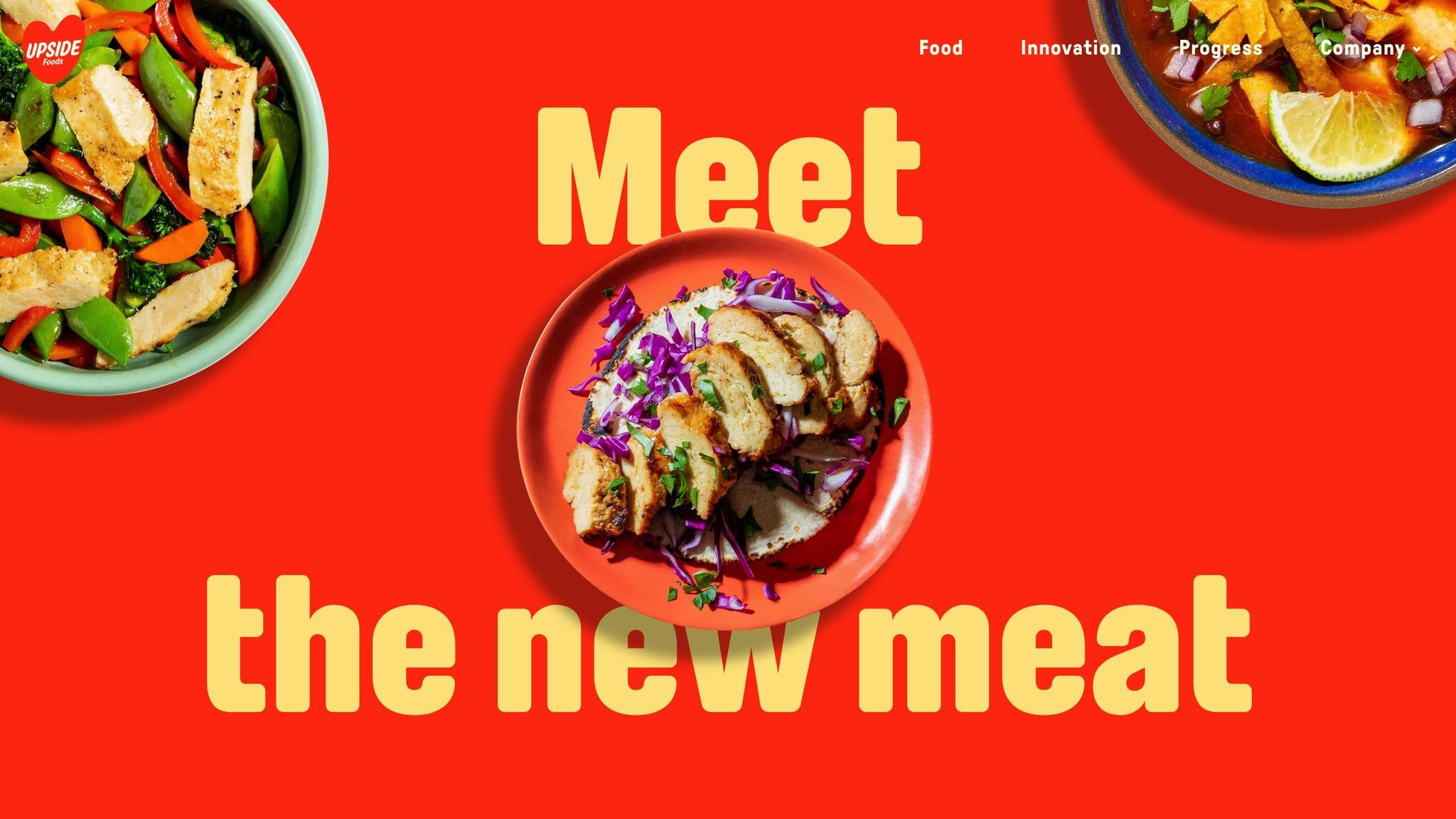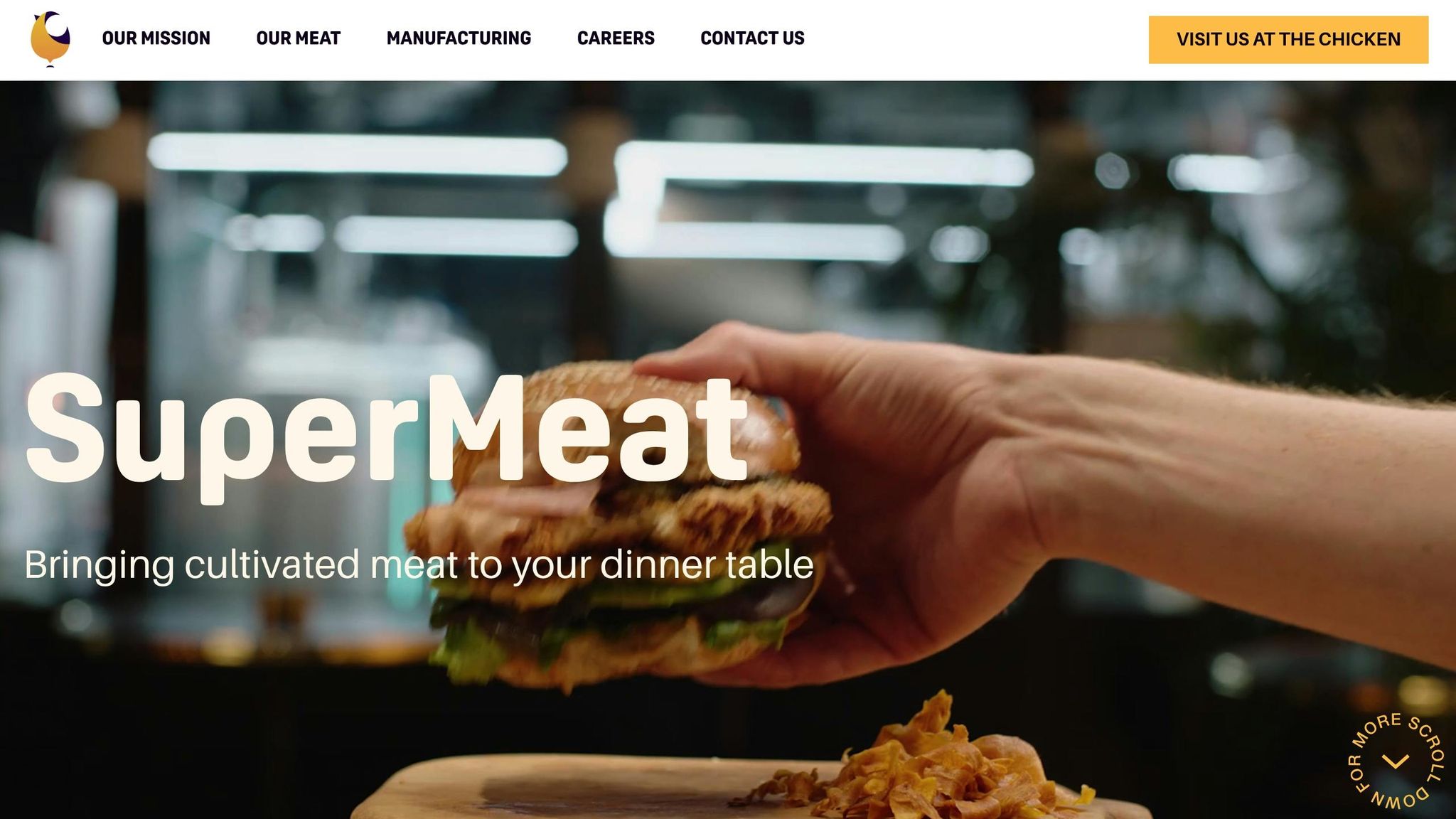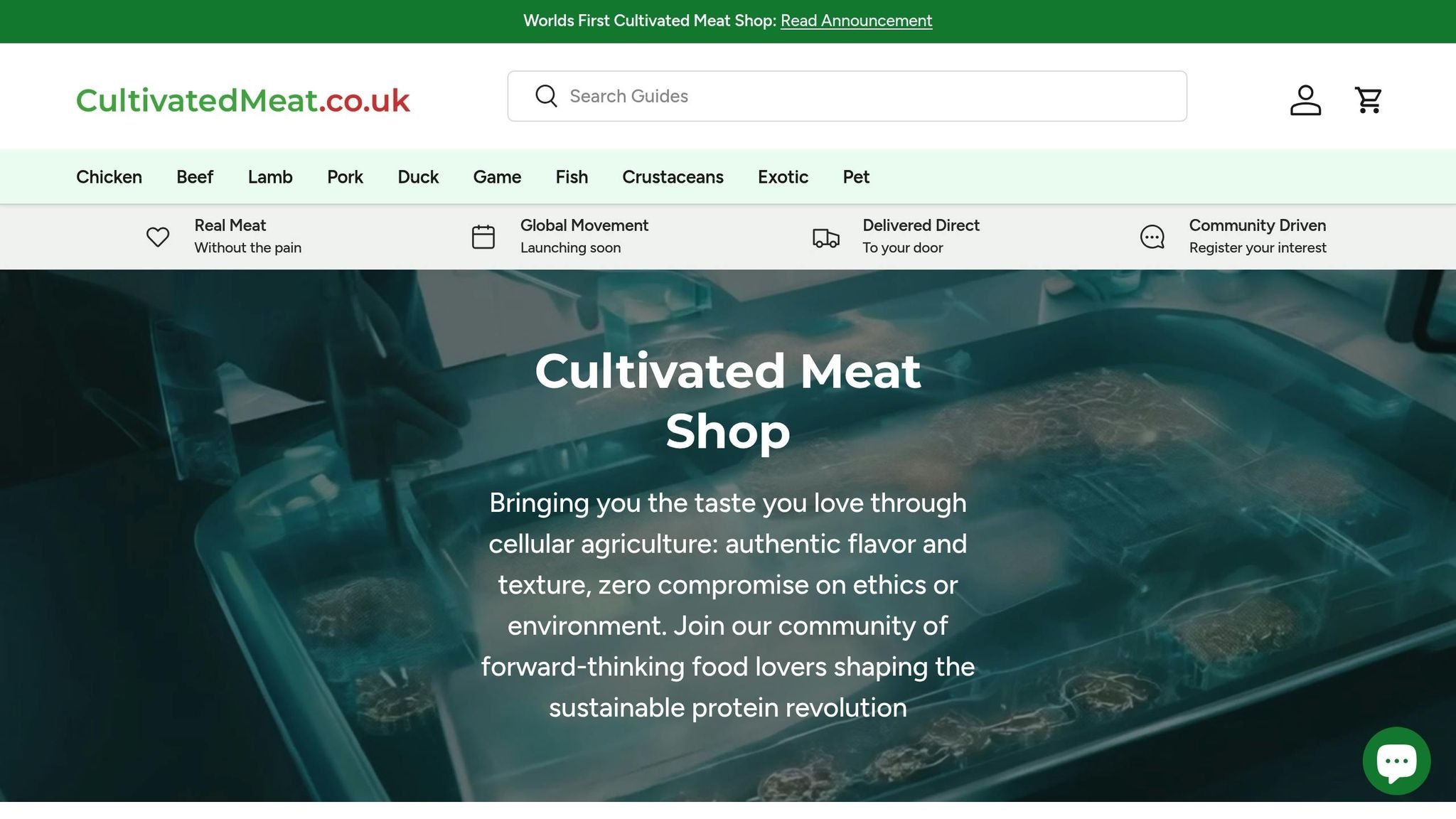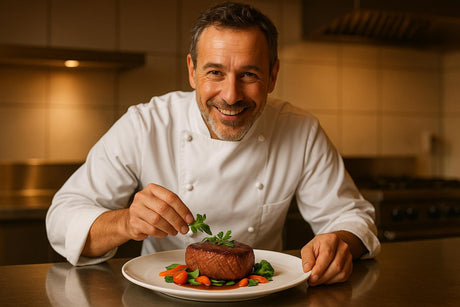Cultivated meat is changing how we produce and consume meat, offering a new way to enjoy familiar flavours while addressing ethical and environmental concerns. With over 175 companies and £2.5 billion in investments, this growing industry is teaming up with top chefs to refine products, build trust, and introduce these innovations to diners. Here’s what’s happening:
- Chef Partnerships: Michelin-starred chefs like Daniel Calvert and Claude Le Tohic are working with cultivated meat brands to perfect taste and texture.
- Product Integration: Companies like UPSIDE Foods and SuperMeat involve chefs in product development, creating dishes like chicken shawarma tacos and cell-based nuggets.
- Consumer Trust: Transparent facilities, such as SuperMeat’s “The Chicken,” allow diners to see production processes, boosting confidence.
- Luxury Options: Gourmey collaborates with chefs to develop cultivated foie gras, addressing ethical concerns around traditional foie gras production.
- Market Expansion: Platforms like Cultivated Meat Shop aim to educate UK consumers, preparing them for the future of meat alternatives.
These collaborations are helping cultivated meat gain acceptance by combining culinary expertise with cutting-edge production methods, ensuring it meets the expectations of both chefs and diners.
1. UPSIDE Foods and Pat LaFrieda: Connecting Traditional and New Methods

The partnership between UPSIDE Foods and Pat LaFrieda Meat Purveyors is bringing cultivated meat into mainstream dining. In January 2025, they joined forces to distribute cultivated chicken to restaurants across the United States, combining cutting-edge technology with traditional meat expertise [5].
Chef Involvement in Product Development
Pat LaFrieda's culinary team worked closely with UPSIDE Foods to incorporate cultivated chicken into familiar recipes. This collaboration resulted in practical applications like shredded chicken and chicken sausage, along with dishes such as breakfast sandwiches, garlic noodles with panko-crusted chicken, chicken shawarma tacos, and chicken empanadas [4][5].
Impact on Public Acceptance of Cultivated Meat
By utilising Pat LaFrieda's extensive restaurant network, this partnership is helping to introduce cultivated meat to diners in familiar settings. This approach plays a critical role in addressing consumer hesitation towards new food products [4]. Amy Chen, COO of UPSIDE Foods, shared their vision for the future:
"We believe it is important for consumers to have an amazing first experience with cultivated meat and to fall in love with it. Longer-term, as we think about these partnerships, consumers will experience UPSIDE chicken at their favourite restaurant or with their favourite recipes in their favourite food service establishments and ultimately retail" [4].
Nick Solares, brand ambassador for Pat LaFrieda, highlights the appeal of cultivated chicken:
"UPSIDE's cultivated chicken 'succeeds' as an alternative protein 'because it is not replacing chicken. It is chicken.'" [4]
Culinary Methods and Creativity
This collaboration showcases how traditional meat expertise can elevate cultivated meat products. With decades of experience in meat preparation and distribution, Pat LaFrieda brings valuable insights into texture, flavour, and cooking techniques that complement cultivated chicken. By introducing these products through established restaurant channels, chefs can fine-tune recipes and experiment with cultivated meat in professional kitchens before it becomes widely available in retail.
This chef-driven approach ensures that cultivated meat is ready for high-volume food service environments, maintaining consistent quality and performance. It also provides a pathway for cultivated meat to enter the US restaurant scene, offering a practical model for integrating new protein solutions into established culinary practices. This partnership not only bridges the gap between tradition and innovation but also sets the stage for future collaborations in the cultivated meat industry [4].
2. SuperMeat and Restaurant Tastings: Chef-Led Consumer Acceptance

SuperMeat has introduced a unique farm-to-fork facility called "The Chicken", where visitors can watch the entire production process through a glass wall. This one-of-a-kind setup not only highlights transparency but also fosters deeper collaboration with chefs and builds consumer confidence.
Chef Involvement in Product Development
SuperMeat is blending culinary artistry with food science by involving chefs directly in the development of cultivated meat. At their pilot plant, food engineers and chefs work side by side to create meals made with cultivated meat, merging innovation with gastronomy. A 2022 survey conducted by SuperMeat explored the attitudes of US-based chefs towards cultivated meat, providing valuable insights into the needs and expectations of the foodservice industry [6].
Impact on Public Acceptance of Cultivated Meat
The transparent design of "The Chicken" facility plays a key role in addressing consumer hesitations around cultivated meat. Diners can see firsthand how their meals are created and prepared, helping to build trust and demystify the production process [6].
Culinary Methods and Creativity
SuperMeat is starting with cell-based chicken nuggets, offering chefs a familiar ingredient that can easily fit into existing menus. Beyond this, the company is pushing culinary boundaries by creating new flavours, textures, and dining experiences that aren't possible with traditional meat. This approach allows chefs to reimagine classic dishes while also experimenting with entirely new culinary concepts [7].
Environmental and Ethical Considerations
SuperMeat's mission extends beyond culinary innovation to address pressing environmental and ethical issues. The company envisions cultivated meat as a way to improve nutritional security, lower carbon emissions, and enhance food safety - all while providing a more ethical alternative to conventional meat production [6].
3. Michelin-Starred Chefs and Gourmey: Improving Cultivated Foie Gras
Gourmey, a Paris-based company specialising in cultivated foods, has brought together a culinary advisory board featuring three Michelin-starred chefs who collectively hold eight Michelin stars [8]. This elite team includes Claude Le Tohic (three stars), Daniel Calvert (three stars), and Rasmus Munk (two stars). Their mission? To help refine Gourmey's cultivated foie gras, combining cutting-edge innovation with the artistry of fine dining.
Chef Involvement in Product Development
These renowned chefs are deeply involved in shaping Gourmey's cultivated foie gras. By working closely with the company, they provide expert feedback to fine-tune textures and flavours, ensuring the product meets the rigorous demands of haute cuisine [8].
"This culinary advisory board will be key in shaping Gourmey's product characteristics and qualities, ensuring the highest standards in gastronomy are applied and supporting in the creation of pairings and flavours." [8]
Their influence extends beyond feedback. For instance, Claude Le Tohic has used cultivated foie gras to create a marbled dish at his San Francisco restaurant, while Daniel Calvert has incorporated it into a lacquered Peking Duck served in Tokyo [8]. These creations demonstrate the versatility and potential of the product in high-end culinary settings.
Impact on Public Acceptance of Cultivated Meat
The involvement of Michelin-starred chefs lends significant credibility to cultivated foie gras. Their endorsement signals to chefs, diners, and the wider culinary world that this product can hold its own in the most demanding kitchens.
Claude Le Tohic shared his thoughts on the product:
"I had the pleasure of trying Gourmey's cultivated foie gras, and I was impressed. Its colour and exceptional consistency truly stand out at first sight. The flavour is well-balanced, and the texture maintains a delightful uniformity." [8]
This kind of praise from a chef of his calibre not only boosts confidence in the product but also helps to break down scepticism surrounding cultivated meats.
Environmental and Ethical Considerations
This collaboration also addresses longstanding ethical concerns tied to traditional foie gras production. Conventional methods involve force-feeding ducks and geese to enlarge their livers - a process that has led to bans in 17 countries, including the UK, where 79% of people support such restrictions [10][11][12]. By offering a cultivated alternative, Gourmey is tackling these issues head-on.
Rasmus Munk, chef at Copenhagen's The Alchemist, highlighted the ethical advantages:
"Cultivated foie gras represents an opportunity to bring back a beloved but often banned ingredient to the chef's toolbox, and I think that every step towards improving animal welfare is tremendously important." [8]
Daniel Calvert, meanwhile, emphasised the sustainability aspect:
"I am joining Gourmey's culinary board to be part of a new initiative towards a more sustainable culinary future. I would like my guests to approach this experience as I did, with an open mind." [8]
Gourmey is also pushing forward on the regulatory front, having submitted market approval applications in Europe, the US, Switzerland, and the UK. In July 2024, it became the first company to apply for approval to sell cultivated meat in the European Union, positioning itself as a leader in this emerging field [9].
4. Chef-Led Research and Development Partnerships: Building the Future of Cultivated Meat
Chef-led partnerships are reshaping the development of cultivated meat, blending culinary expertise with food technology to create products that meet the high expectations of professional kitchens. These collaborations not only elevate the quality of cultivated meat but also help build consumer trust and acceptance.
Chef Involvement in Product Development
To refine the flavour, texture, and versatility of cultivated meat, many companies are bringing chefs on board as R&D Culinary Consultants. These chefs play a pivotal role by providing feedback on product attributes, offering insights into cost-effectiveness, and pushing the boundaries of innovation.
One standout example is Clever Carnivore, which works closely with culinary consultants. Kaitlin Grady from Clever Carnivore highlighted this approach, stating:
"Chef engagement has been top of mind as we develop our prototype products." [3]
Impact on Public Acceptance of Cultivated Meat
Beyond product development, chefs lend their credibility to cultivated meat, helping bridge the gap between cutting-edge food technology and traditional culinary practices. Their endorsements carry weight, making the concept more relatable and acceptable to consumers. Kevin Markey, a Ph.D. candidate at the University of Vermont's Foods Lab, underscored this dynamic:
"As a chef, my main take away from CMS23 is the need for collaborative innovation between scientists and chefs. While the replication of farm-raised meat taste and texture is vital, these principles will come in time as cultured meat is more readily available. The more that cultured meat companies realise the role chefs play as trusted translators of culinary arts and science, the more culturally acceptable cultured meat will become." [3]
Culinary Methods and Creativity
Restaurants are becoming essential testing grounds for cultivated meat, offering chefs the chance to experiment with preparation methods and gather direct sensory feedback. Their creative problem-solving skills help unlock new applications, while their ability to adapt products for different cuisines ensures broader appeal [2].
Environmental and Ethical Considerations
Chef-led collaborations often highlight the sustainability and ethical advantages of cultivated meat. These partnerships give chefs the opportunity to embrace sustainable culinary practices and address animal welfare concerns. For chefs who have avoided certain ingredients on ethical grounds, cultivated meat offers a way to reintroduce those flavours into their menus.
5. The Role of Cultivated Meat Shop in the Changing Culinary Landscape

As chef collaborations reshape the cultivated meat industry, Cultivated Meat Shop has emerged as a key player, serving as the first consumer-focused platform dedicated to this innovative food category. The platform is paving the way for a future of sustainable dining by bridging the gap between chef-driven creativity and consumer understanding.
Impact on Public Acceptance of Cultivated Meat
One of the platform's main contributions lies in building trust around cultivated meat technology. According to a Food Standards Agency poll, 34% of UK consumers are open to trying cultivated meat products [14]. By offering clear, science-backed information about how this meat is produced and its benefits, Cultivated Meat Shop helps address the scepticism that often accompanies new food technologies.
Chef Alexis Gauthier expressed the culinary industry's eagerness for this innovation:
"We're ready. We chefs are hungry for your work. And when the time comes, we'll be first in line to use these creations in our kitchens." [7]
Culinary Methods and Creativity
As consumer acceptance grows, the platform also inspires culinary innovation by showcasing a wide range of cultivated meat products. From staple options like chicken and beef to more adventurous offerings like cultivated foie gras, Cultivated Meat Shop highlights the creative possibilities this technology brings to the table. These previews give chefs a chance to experiment with new menu ideas while addressing ethical concerns.
The platform also helps chefs understand the technical aspects of working with cultivated meat. Early products will likely focus on ground meat applications, such as burgers and sausages, with more complex options like steaks and fillets expected to follow [13][15]. This insight allows chefs to prepare for the evolving market and plan their menus accordingly.
Environmental and Ethical Considerations
Educational content on the platform emphasises the environmental advantages of cultivated meat, such as a 92% reduction in greenhouse gas emissions and 90% less land use compared to traditional beef production [1]. For UK chefs increasingly prioritising sustainability, this information is invaluable in aligning their practices with modern dining trends.
With over 175 companies in the industry and more than £2.5 billion in investments driving its growth [1], early engagement with platforms like Cultivated Meat Shop can position chefs and restaurants as leaders in this transformative sector. By joining the waitlist or exploring the platform’s resources, culinary professionals can stay ahead in integrating sustainable, ethical options into their kitchens. This proactive approach not only supports environmental goals but also strengthens public acceptance of cultivated meat through chef-driven advocacy and consumer education.
sbb-itb-c323ed3
Partnership Comparison Table
Chef-brand collaborations in the cultivated meat industry highlight a range of strategies aimed at product development and consumer acceptance. These partnerships leverage everything from traditional culinary expertise to Michelin-starred innovation, creating a dynamic and evolving landscape.
UPSIDE Foods has teamed up with chefs like Dominique Crenn to perfect their textured cultivated chicken. By incorporating feedback from chefs and diners, they’ve developed a product versatile enough for grilling, frying, or breading - methods familiar to both chefs and consumers. One taster described the product as:
"remarkably authentic in flavour" [16]
Gourmey collaborates with Michelin-starred chefs to position its cultivated foie gras as a luxury item. Signature dishes, such as marbled foie gras with five spices and lacquered Peking duck, showcase its versatility. Chefs have praised its aroma profile, which combines roasted top notes with buttery, caramel-like heart notes and an intense, meaty finish [2].
Meatable focuses on hybrid pork sausages, blending 28% cultivated pork fat with plant-based ingredients. This approach balances cost and flavour while introducing consumers to cultivated meat. At their first public tasting event in the EU, attendees described the sausages as:
"remarkably delicious" [17]
These brands, alongside others like Good Meat, are shaping the cultivated meat industry through varied approaches. Below is a comparison of key partnerships and their contributions:
| Partnership | Product Focus | Key Contribution | Market Approach | Consumer Impact |
|---|---|---|---|---|
| UPSIDE Foods & Dominique Crenn | Cultivated Chicken (Textured) | Chef feedback and restaurant testing | Premium dining establishments | Familiar cooking methods for easier adoption |
| Gourmey & Michelin-Starred Chefs | Cultivated Foie Gras | Luxury positioning and gourmet dishes | High-end restaurants and culinary boards | Elevates product with culinary prestige |
| Good Meat & José Andrés | Cultivated Chicken | Consumer tastings via restaurants | Casual dining and experimental venues | Builds early consumer interest |
| Meatable & Ron Blaauw | Hybrid Pork Sausages | Cost-effective hybrid products | Public tasting events and chef partnerships | Introduces cultivated meat in a familiar format |
These collaborations highlight the industry's multi-faceted approach to gaining market acceptance. Michelin-starred partnerships create aspirational appeal, while restaurant-first strategies provide controlled environments for consumer exposure. Hybrid products, on the other hand, offer a cost-conscious entry point while maintaining familiar taste profiles.
The variety in these strategies reflects a clear understanding: cultivating consumer trust and interest in this new category requires diverse methods. By addressing everything from product quality to consumer education, these partnerships are paving the way for cultivated meat's broader commercial success.
Conclusion
The collaboration between top chefs and cultivated meat brands marks a turning point in how we think about food production. When chefs with established reputations back cultivated meat, it sends a clear message to the public: these products are not only credible but also worthy of serious attention.
Take Neil Perry's work with Vow in 2024 as an example. By crafting inventive dishes with six types of cultivated meats, including kangaroo and alpaca, Perry showcased the culinary possibilities of this new category. Similarly, Michelin-starred chef Eyal Shani partnered with Aleph Farms to introduce cultivated beef steaks through exclusive dining events, further demonstrating the versatility and potential of this emerging food technology [18][19].
These chef-led projects have done more than just highlight quality - they’ve helped speed up commercialisation. By introducing cultivated meat in real-world restaurant settings, they’ve sparked consumer interest and built trust through memorable dining experiences that prove these products can shine in practical, everyday use.
Adding to this momentum, platforms like Cultivated Meat Shop are helping to prepare British consumers for this shift. By offering educational resources, product insights, and opportunities for engagement, they complement the strides made by chefs. This approach ensures that when cultivated meat becomes widely available in the UK, consumers will not only understand it but will be ready to welcome it into their kitchens.
The journey ahead for cultivated meat relies on continued teamwork between chefs, innovators, and educational initiatives. Together, they are redefining meat production, paving the way for a future that prioritises sustainability, ethics, and informed choices - all while building on the strong foundation of chef-driven advocacy and consumer education.
FAQs
How do collaborations with top chefs improve the quality and appeal of cultivated meat?
Collaborating with renowned chefs is a game-changer for refining the taste, texture, and overall experience of cultivated meat. Their culinary skills and deep understanding of flavours ensure that cultivated meat meets the high standards expected in the kitchen.
When chefs create inventive dishes featuring cultivated meat, they make it more approachable and appealing to a wider audience. By blending it into recipes that resonate with local tastes, they bridge the gap between innovation and tradition. Plus, chefs act as trusted advocates, presenting cultivated meat as not only a safe and delicious option but also a premium alternative to conventional meat. This helps build confidence and speeds up its acceptance in the market.
How do transparent production facilities help build trust in cultivated meat?
Why Transparent Production Matters in Cultivated Meat
Building consumer trust is crucial for the success of cultivated meat, and transparent production facilities play a big role in this. By openly showing how these products are made, companies can highlight their dedication to safety, ethical standards, and compliance with strict regulations. This level of openness helps ease any doubts consumers may have about the quality and reliability of the products.
Clear communication about the production process also helps tackle common concerns surrounding new food technologies. When companies align their practices with ethical principles and provide clarity, they make it easier for people to understand and accept cultivated meat. Transparency, in this sense, becomes a vital element in encouraging the public to see cultivated meat as a responsible and forward-thinking protein option.
How does cultivated foie gras address ethical and environmental concerns?
Cultivated Foie Gras: A Humane Alternative
Cultivated foie gras is changing the game by addressing ethical concerns tied to traditional production methods. Unlike conventional foie gras, which relies on force-feeding ducks and geese - a practice heavily criticised for its impact on animal welfare - this alternative is made by growing animal cells in controlled settings. The result? A cruelty-free option that doesn’t compromise on quality.
But it’s not just about ethics. This approach also tackles environmental challenges. Traditional foie gras production involves resource-intensive farming that can harm ecosystems. Cultivated foie gras, on the other hand, avoids these practices, conserving resources and reducing habitat destruction. It’s a step towards a more sustainable and humane way to enjoy this delicacy.













